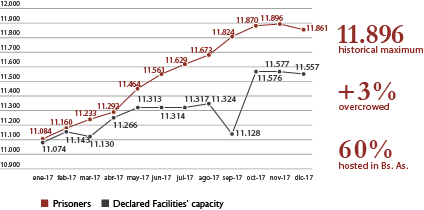Prison overpopulation
The prison overpopulation phenomenon is affected by policies adopted by governments, such as the systematic use of preventive prison, the high use of alternative measures to imprisonment, and the narrow application of anticipated liberty, among others.
The modifications to Law 24.660 by Law 27.375, giving way to the impossibility of transitory releases of criminals convicted of certain crimes, as well as restrictions on the releases of people under arrest, have made the situation even worse.
Until 2016, Argentine federal prisons had been occupied in over 90% of their capacity. However, since 2017 it reached its highest peak of overpopulation ever recorded.
Studies carried out by PPN (see the latest statistics bulletin) showed that since 2015 the Federal Penitentiary System (Servicio Penitenciario Federal, SPF) changed the way prison capacity was informed. It no longer stated the “real capacity” (operational capacity available for accommodation) but instead it pointed out only the “general capacity” (operational capacity in each establishment, including closed or unauthorized areas), which seemed to show a capacity increase.
After an extended period of inconsistencies, the SPF confessed what the real accommodation capacity was.
Thus, it showed that the occupational rate of penitentiary establishments represents at least 103%.
Prison overpopulation

The prison overpopulation phenomenon is affected by policies adopted by governments, such as the systematic use of preventive prison, the high use of alternative measures to imprisonment, and the narrow application of anticipated liberty, among others.
The modifications to Law 24.660 by Law 27.375, giving way to the impossibility of transitory releases of criminals convicted of certain crimes, as well as restrictions on the releases of people under arrest, have made the situation even worse.
Until 2016, Argentine federal prisons had been occupied in over 90% of their capacity. However, since 2017 it reached its highest peak of overpopulation ever recorded.
Studies carried out by PPN (see the latest statistics bulletin) showed that since 2015 the Federal Penitentiary System (Servicio Penitenciario Federal, SPF) changed the way prison capacity was informed. It no longer stated the “real capacity” (operational capacity available for accommodation) but instead it pointed out only the “general capacity” (operational capacity in each establishment, including closed or unauthorized areas), which seemed to show a capacity increase.
After an extended period of inconsistencies, the SPF confessed what the real accommodation capacity was.
Thus, it showed that the occupational rate of penitentiary establishments represents at least 103%.



